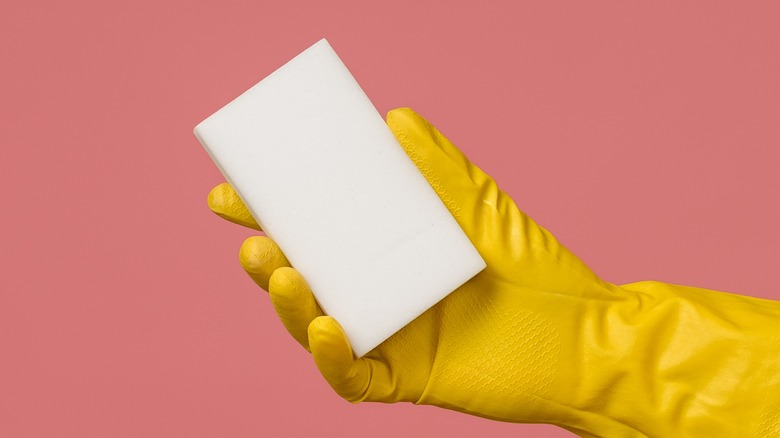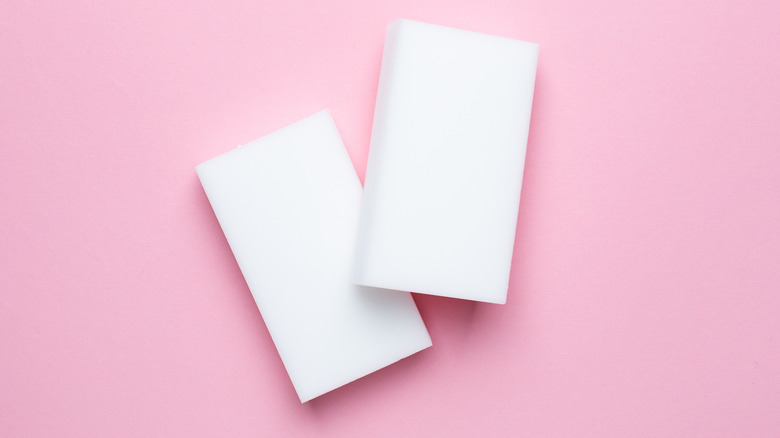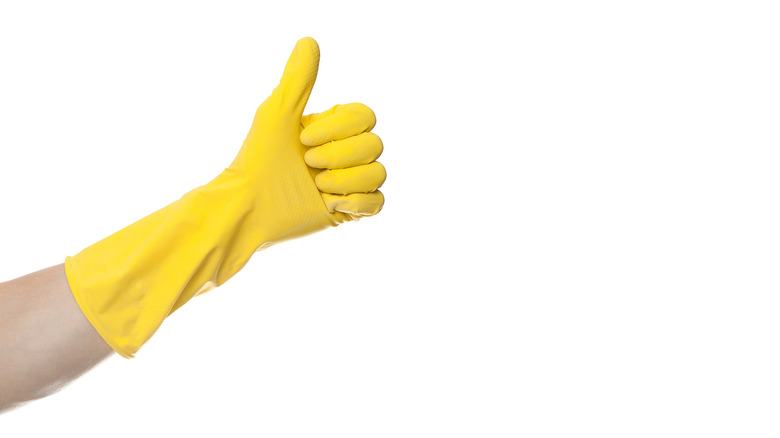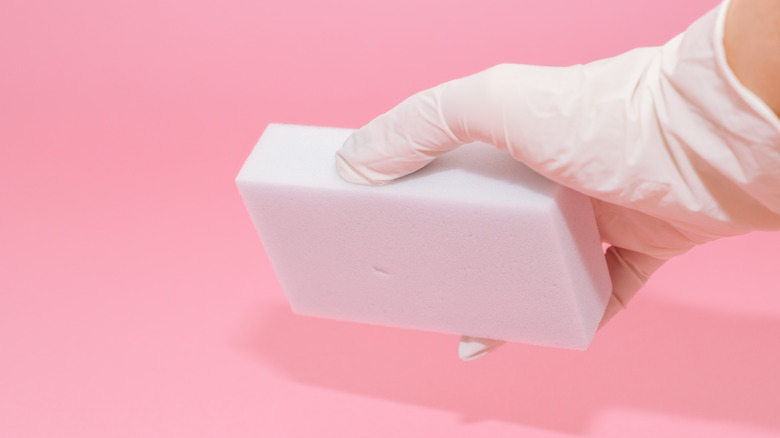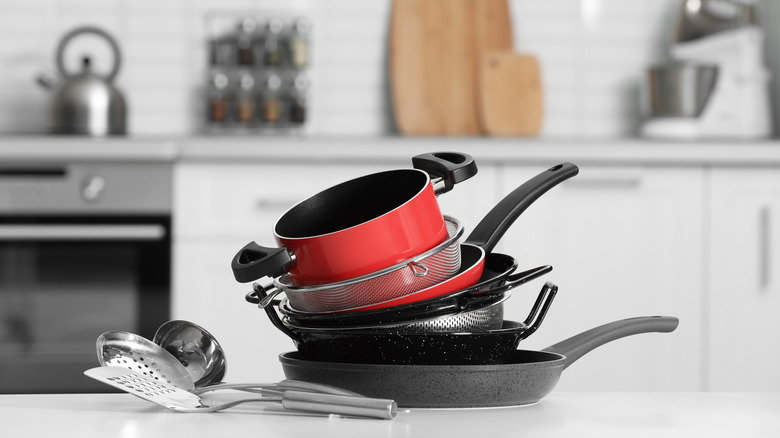5 Mistakes You're Making With A Magic Eraser
We may receive a commission on purchases made from links.
Magic erasers may seem like they work so well because of supernatural forces, but the real reason is melamine foam. This cleaning product is made of an abrasive material that scrubs the top layer of surfaces, buffing away any stains. Maid Sailors explains magic erasers are made by curing melamine resin until it becomes the white foam we recognize, with a microstructure similar to extremely fine sandpaper. That's why magic erasers are so good at removing stains, dirt, and sticky residue.
Since magic erasers are just melamine foam, you can buy the same product for less than half the price if you don't get the brand name. They will work and look the same as Mr. Clean Magic Erasers. On Amazon, the brand name is $5.50 for a pack of two, while generic melamine sponges are $4.00 for 10. You can stretch each eraser even farther by cutting it into smaller pieces.
You use it dry
Magic erasers are easy to use. All you need to do is wet them with a small amount of water, squeeze out the excess, and then start cleaning. The best way to use them is by scrubbing them in small circles. However, if you forget the first step, you can cause detrimental damage to your items. The Maids explains that adding water to your magic eraser allows it to absorb the dirt as it cleans. While you can use the melamine foam without water, not moistening the sponge will make it more abrasive than usual. Then you risk scratching your surfaces.
You'll notice that after you wet and begin using your magic eraser, it crumbles as you use it. This is bound to happen, but there are things you can do to preserve the cleaning product. If you know you're only cleaning small areas, you can cut the foam into smaller portions. Then you won't waste the entire sponge when it crumbles. Maid Sailors also recommends leaving the eraser to air dry before you reuse it.
You don't wear gloves
Since magic erasers are made of super abrasive melamine, they're very powerful, and there are varioius items that you should never use them on. One of the most critical areas to never use a magic eraser is on the skin. After it's cured, the structure of melamine resin turns into 3,000- to 6,000-grit sandpaper. It can leave you with rashes and burns from even a gentle scrub, according to Missouri Poison Center. Essentially, it sands away the top layer of your skin.
ENDA explains that it's unlikely that holding a melamine sponge while you're using it to clean surfaces will damage your hands the same way it will damage your skin. However, it's better to be safe than sorry and wear rubber gloves to prevent direct contact with the product. Doing this is necessary if you have sensitive skin. There are no dangerous cleaning chemicals in the product, but the physical abrasiveness of it can cause harm to your hands.
You forget to do a test patch
Doing a test patch is very important when using magic erasers because they can damage surfaces. This product works by sanding off the top layer of the area that's dirty, not by actually cleaning it. The super-fine sandpaper will work on plastic, painted walls, bathtubs, and sneakers. However, it'll ruin leather, wood, shiny finishes, and protective sealants. If you were to use it on these materials, they would be covered in tiny scratches and look foggy.
To do a test patch, you need to choose an inconspicuous location. Then you won't be able to see the damage if the magic eraser scratched it easily. Once you select a spot that isn't noticeable, move the magic eraser in small circles. My House Cleaning Biz explains that you shouldn't press the sponge down too hard when using it. After you're done, wipe it clean with a damp cloth. Then you can assess the area for any damage. If it looks OK, continue using the magic eraser.
You use it on nonstick pans
Nonstick pans are one of the things you should never use a magic eraser to clean. Not only will it ruin your cookware, but it's dangerous to your health, too. The root of the problem is that melamine foam acts like sandpaper and will scratch the nonstick coating on your pots and pans. These sponges also break down when you get them wet and use them. DIY By Hand explains that a thin residue begins building up on your cookware and dishware if you use magic erasers instead of a generic kitchen sponge. Then those tiny pieces of melamine will mix with your food.
You don't want to scratch the nonstick coating on your pots and pan, either, especially if you purchased them before 2005. In the years before, it was commonplace for the nonstick coating to include perfluorooctanoic acid or PFOA (via Allrecipes). This chemical compound is linked to causing cancer, liver damage, asthma, and decreased fertility, according to the Harvard School of Public Health. Once the coating is scratched, it can chip off into your food and expose you.
You use it on stainless steel or porous countertops
Stainless steel appliances and natural stone countertops are other common places people may want to use magic erasers, although that isn't a good idea. These surfaces often have a seal or varnish that the melanin foam will damage. Further, doing this to granite or marble countertops will make any stain worse than it originally was. The magic eraser will remove the stain you were trying to clean, but it'll take the top layer of your sealant with it, according to Countertop Specialty. Then the natural stone is exposed, leaving it open to absorbing a new stain easily.
With stainless steel appliances, the sandpaper of the magic eraser will clean off the stain, but also the appliance's high gloss finish. The main appeal of stainless steel is how shiny it looks. After using a melamine sponge, the scratched metal will start to patina and have foggy spots (via First For Women). Unfortunately, there's almost nothing you can do to get these scratches out of the stainless steel after they've already been made.
